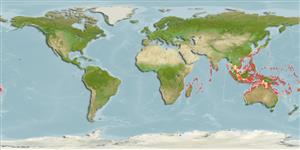Classification / Names
Common names from other countries
Main reference
Size / Weight / Age
Max length : 12.0 cm TL male/unsexed; (Ref. 48635)
Environment
Marine; demersal; depth range 3 - 43 m (Ref. 106976)
Climate / Range
Tropical, preferred ?; 37°N - 27°S, 107°E - 178°W (Ref. 106976)
Distribution
Indo-West Pacific: from southern Japan (except Ryukyu Islands), Vietnam, Indonesia, Papua New Guinea, Fiji, Australia, Taiwan, India, and the Red Sea.
Countries | FAO areas | Ecosystems | Occurrences | Introductions
Short description
Dorsal
spines
(total): 12;
Dorsal
soft rays
(total): 9;
Anal
spines: 2;
Anal
soft rays: 6. This species is distinguished by the following characters: A II,6; dorsal-fin spines flexible, bend easily under slight pressure; snout is relatively short, 12.3-17.0% (mean 14.3%) of SL, it is shorter than postorbital length; posterior margin of maxilla reaching to or extending beyond vertical through middle of pupil; the distance between tips of lateral lacrimal and the first suborbital spines is shorter than or subequal to that between tips of first and second suborbital spines; no supplemental preopercular spine; tentacles on supraocular and posterior lacrimal spines are well developed, their lengths greater than orbit diameter; trunk and fins with numerous tentacles; lateral lacrimal and suborbital spines are poorly developed, indistinct, usually tiny spines and often bony protuberances without pointed tips; absence of distinct black blotch on soft-rayed portion of dorsal fin (Ref. 106976).
IUCN Red List Status (Ref. 115185)
Threat to humans
Harmless
Human uses
More information
Common namesSynonymsMetabolismPredatorsEcotoxicologyReproductionMaturitySpawningFecundityEggsEgg development
ReferencesAquacultureAquaculture profileStrainsGeneticsAllele frequenciesHeritabilityDiseasesProcessingMass conversion
Tools
Special reports
Download XML
Internet sources
Estimates of some properties based on models
Phylogenetic diversity index
PD50 = 0.5625 many relatives (e.g. carps) 0.5 - 2.0 few relatives (e.g. lungfishes)
Trophic Level
3.6 ±0.6 se; Based on size and trophs of closest relatives
Resilience
High, minimum population doubling time less than 15 months (Preliminary K or Fecundity.)
Vulnerability
Low to moderate vulnerability (28 of 100)
Price category
